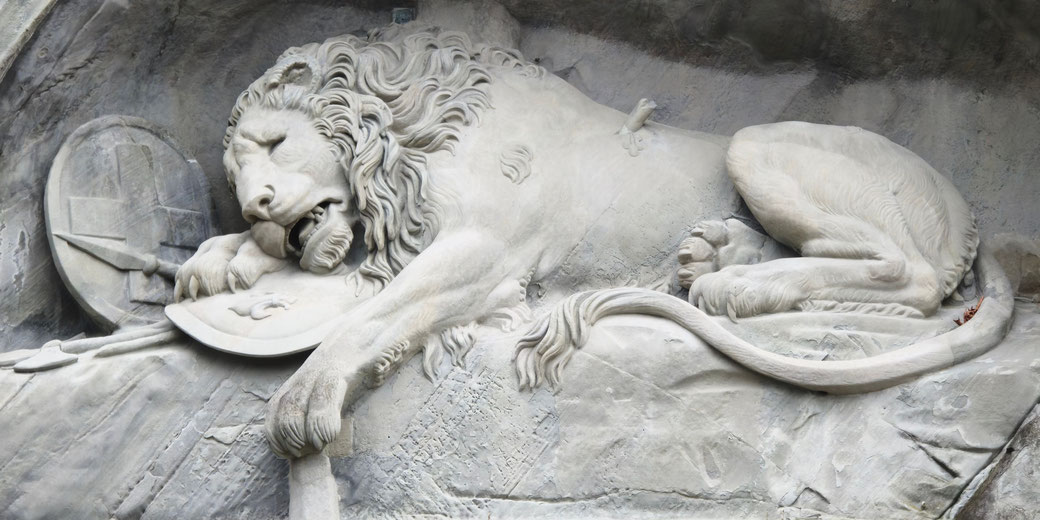The history behind the Swiss Lion Monument in Lucerne and its link to the French Revolution

In the middle of Lucerne there is a massive sculpture of a fatally wounded lion that recalls the day when Swiss soldiers, fighting under an oath to the French crown, died defending the Tuileries Palace against revolutionary forces in Paris.
Since then, it has become a famous monument honouring a people’s reputation for loyalty and sacrifice in the face of certain death.
The Swiss Guards in French royal service
Swiss soldiers had become known for their discipline and courage, and had been operating as mercenaries across Europe for centuries.
In 1616, a treaty signed by King Louis XIII and the Swiss cantons formally guaranteed that a regiment of Swiss Guards would serve the French crown.
They became part of the royal household troops and were stationed in Paris to protect the king and his family.
Their oath bound them personally to the monarch, which obliged them to defend him under any circumstances.
Over the course of two and a half centuries, approximately 500,000 men were sent to France to fulfill their duty: 60% of which never returned home.
The outbreak of the French Revolution in 1789 brought an intensifying crisis for the monarchy when the storming of the Bastille and the abolition of feudal privileges highlighted the collapse of royal authority.
In June 1791, Louis XVI tried to flee his own country by escaping to the border town of Varennes.
However, he was quickly recognised, and taken back to Paris. This debarcle further damaged the king’s reputation with the French people.
In fact, many revolutionaries came to see him as a traitor who plotted with foreign powers.
So, when the revolutionary government in France declared war on Austria in April 1792, the climate in Paris became violent and unstable, as many feared that the king would side with their enemies.
As the danger to the safety of royal family increased, the Swiss Guards openly remained loyal to their original oath.

The storming of the Tuileries Palace
On 10 August 1792, about 900 Swiss Guards stood ready to defend the Tuileries Palace as thousands of armed revolutionaries and National Guardsmen surrounded it under the overall authority of Antoine Joseph Santerre.
When the crowd advanced, the Swiss Guards defended the palace in desperate close combat.
They used their muskets and bayonets to hold back the attackers. Louis XVI was fearful of a massacre and ordered the Guards to cease fire and withdraw.
Unfortunately, his indecision only created confusion, and the attackers overwhelmed the defenders.
Roughly 600 Guards were killed either in battle or after capture, while about 300 revolutionaries and National Guardsmen were left dead or wounded.
Eyewitness accounts describe horrific scenes as revolutionaries butchered the wounded and mutilated bodies.
Many captured Guards were summarily executed at the Hôtel de Ville or in the streets of Paris even after surrendering.
A few Guards escaped or were hidden by supportive Parisians, but most were slaughtered.
For their part, the royal family was arrested and imprisoned in the Temple, which ended any possibility of restoring royal authority over the country.
Ultimately, the fall of the Tuileries cleared the way for the abolition of the monarchy all together and the creation of the French Republic the following month.
The aftermath of the massacre
The destruction of the Guards caused anger across Europe, since various monarchs viewed their deaths as proof of the Revolution’s brutality.
Karl Pfyffer von Altishofen, an officer of the regiment who had been on leave in Lucerne during the massacre, dedicated himself to keeping the memory of his comrades alive.
After collecting various first-hand accounts, he published a full report in 1819 which described the events and the Guards’ final moments, and he worked to find funtds to build a memorial to ensure their sacrifice was not forgotten.
When collecting funds began in the early nineteenth century, Pfyffer received donations from Swiss citizens and foreign monarchs who respected the loyalty shown by the Guards.
Danish sculptor Bertel Thorvaldsen provided the design, and Lukas Ahorn carved the monument into a sandstone cliff.
It includes an inscription in Latin (a language that most people could read at the time), and it records the names of the officers who lost their life in the fighting, rather than the names of all of the victims.
Work took place between 1819 and 1821, and the monument was officially inaugurated in August 1821.
The dying lion, that had been pierced by a spear, rests on a shield bearing the fleur‑de‑lis, with another shield displaying the Swiss coat of arms.
The final monument measures about ten metres in length and six metres in height.

The historical importance of the memorial
On the surface, the Lion Monument became a centre for memory of the events of 1792, but the story of the Guards started to feed into growing debates in Switzerland about the ethics of mercenary service.
After the Sonderbund War of 1847, discussions about foreign service grew louder, and in 1848 the newly formed Swiss Confederation banned military service for foreign powers, apart from the Papal Swiss Guard in Rome.
Regardless, visitors from across Europe came Lucerne to see the monument during the nineteenth century, and upon his visit in the 1880s Mark Twain famously called it “the saddest and most moving piece of rock in the world”.
Tourists today can still see a work of art and a memorial to a sad event that ended an ancient bond between the Swiss cantons and the French monarchy.
What do you need help with?
Download ready-to-use digital learning resources
Copyright © History Skills 2014-2025.
Contact via email
With the exception of links to external sites, some historical sources and extracts from specific publications, all content on this website is copyrighted by History Skills. This content may not be copied, republished or redistributed without written permission from the website creator. Please use the Contact page to obtain relevant permission.





